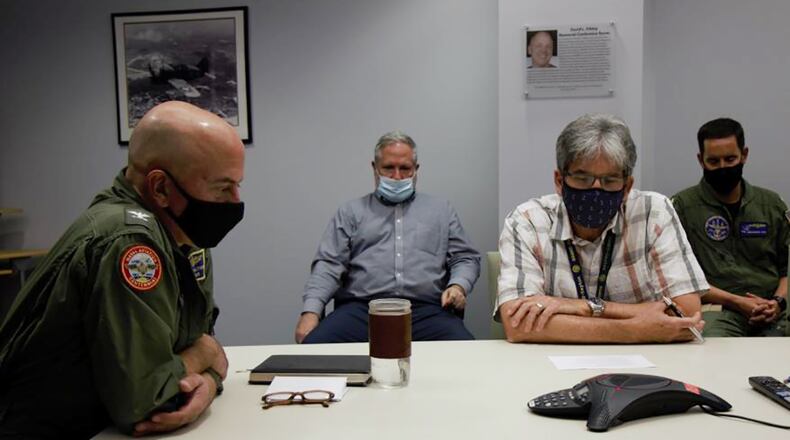The eyewear allows continued visualization of the cockpit instruments despite the laser threat. The team not only developed a new, state-of-the-art product specifically for the military, but also a variant that can be sold to private aviators as well as the civilian airline industry after Federal Aviation Agency approval.
They were recognized by the Surgeon General of the Navy, Rear Adm. Bruce Gillingham for their work in developing a monumental research achievement supporting aviation operations during a ceremony Nov. 9 at the Naval Medical Research Unit – Dayton on Wright-Patterson Air Force Base.
“This was terrific work, thank you!” Gillingham said. “This is incredibly relevant to the potential aviation mishaps you will prevent in the future.” The Green X spectacles are specially designed eyewear resembling sunglasses that pilots can wear in dark conditions that protect them from potential dangers faced when laser devices of various types are aimed through the cockpit intending to disrupt the pilot’s vision and impact their specific mission taskings.
In some cases, according to NAMRL subject matter experts, Coast Guard pilots attempting night rescues were forced to re-attempt those approaches after interference from laser-wielding individuals. It was in this environment that the tasking to Dr. Reddix and his team was envisioned. According to the NAMRL team, to be acceptable, the solution would need to be compatible with cockpit instrumentation, night vision goggles, head-up displays and out-of-cockpit visual aids. “The Laser Eye Projection spectacle is compatible with all six (Coast Guard) aircraft platforms,” said Lt. Cmdr. Brennan Cox, NAMRL deputy director. “This remarkable team effort transitioned research from Advanced Technology Development … to a fielded, operational product in just five years, directly addressing a fleet need for combating an emerging airspace threat.”
Reddix is a senior research scientist at NAMRU-D, having retired from the Navy as a Commander in the Medical Service Corps. He and his team collaborated across the services, although the original concept came several years before the research was developed and funded. After coordinating with the interested parties, the research began in earnest to develop and field the products to counter the danger the lasers presented.
“The Coast Guard came to us in 2013 and asked for help; they not only wanted to know when they were being lased but also wanted to locate the source” Reddix said. “This was designated an ‘urgent operational need’ – we needed to leverage $10 million worth of research to address the challenges faced by modern cockpits which feature heads-up displays. (Several different colors of lasers) presented a challenge to visibility while using those systems.”
Capt. Walter Dalitsch III, NAMRU-D commanding officer, noted the fact that Dr. Reddix is “a legend in the aerospace medicine community” but also that he remained “in shock and awe of the amazing accomplishments of the scientists assigned here.
“The collaboration with other services and the key partnerships that helped accomplish this mission is representative of what a great family and team we have at Dayton,” Dalitsch said.
Reddix credits the collaboration with the Air Force that came as a result of the 2010 Base Realignment and Closure process that co-located NAMRL and the Environmental Health Effects Lab under NAMRU-D as well as with the Air Force’s 711th Human Performance Wing. He saved his most significant praise for his team, particularly “the wing wearers” within the Medical Service Corps assigned here whose on-site flight testing of the spectacles during flight with the Coast Guard allowed the process to be completed.
These members included Lt. Cmdr. Michael Tapia, Lt. Cmdr. Adam Preston and Lt. Sarah Sherwood from NAMRL. One more civilian professional, Bernadette McCann, rounded out the research team. “It would not have happened without them,” he said.
NAMRU-D, which is made up of NAMRL and the Environmental Health Effects Laboratory (EHEL), is a medical research command focused on the enhancement of human performance and protection in extreme environments. The command optimizes the readiness, performance and survivability of operational forces through environmental health effects, toxicology and aerospace medical research and development. NAMRU-D is located at Wright-Patterson Air Force Base.
About the Author
